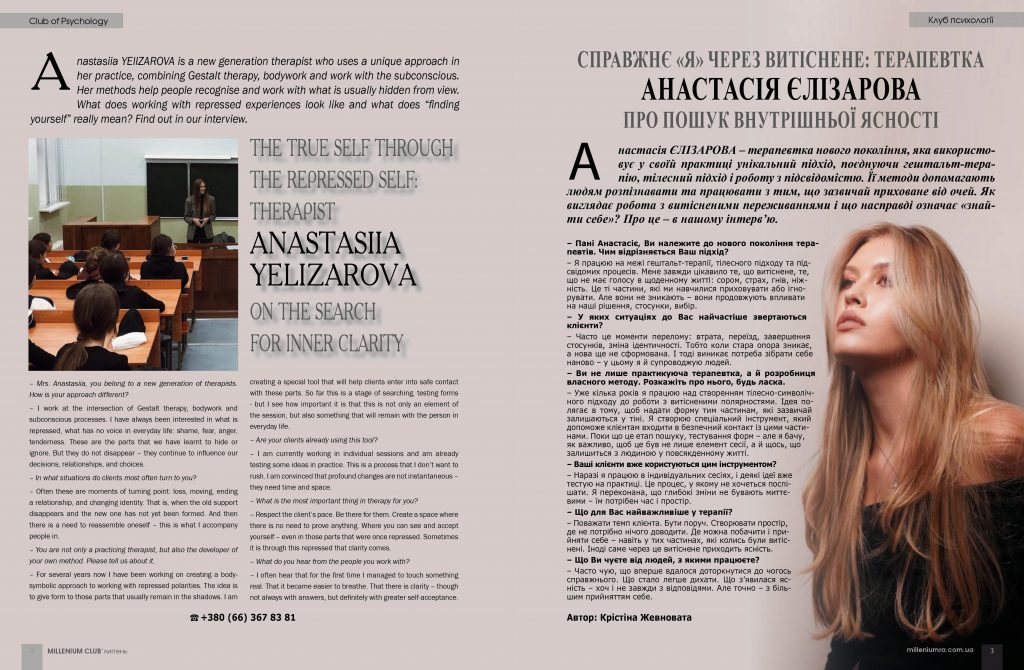07.07.2021
Анастасія ЄЛІЗАРОВА – терапевтка нового покоління, яка використовує у своїй практиці унікальний підхід, поєднуючи гештальт-терапію, тілесний підхід і роботу з підсвідомістю. Її методи допомагають людям розпізнавати та працювати з тим, що зазвичай приховане від очей. Як виглядає робота з витісненими переживаннями і що насправді означає «знайти себе»? Про це – в нашому інтерв’ю.

– Пані Анастасіє, Ви належите до нового покоління терапевтів. Чим відрізняється Ваш підхід?
– Я працюю на межі гештальт-терапії, тілесного підходу та підсвідомих процесів. Мене завжди цікавило те, що витіснене, те, що не має голосу в щоденному житті: сором, страх, гнів, ніжність. Це ті частини, які ми навчилися приховувати або ігнорувати. Але вони не зникають – вони продовжують впливати на наші рішення, стосунки, вибір.
– У яких ситуаціях до Вас найчастіше звертаються клієнти?
– Часто це моменти перелому: втрата, переїзд, завершення стосунків, зміна ідентичності. Тобто коли стара опора зникає, а нова ще не сформована. І тоді виникає потреба зібрати себе наново – у цьому я й супроводжую людей.
– Ви не лише практикуюча терапевтка, а й розробниця власного методу. Розкажіть про нього, будь ласка.
– Уже кілька років я працюю над створенням тілесно-символічного підходу до роботи з витісненими полярностями. Ідея полягає в тому, щоб надати форму тим частинам, які зазвичай залишаються у тіні. Я створюю спеціальний інструмент, який допоможе клієнтам входити в безпечний контакт із цими частинами. Поки що це етап пошуку, тестування форм – але я бачу, як важливо, щоб це був не лише елемент сесії, а й щось, що залишиться з людиною у повсякденному житті.
– Ваші клієнти вже користуються цим інструментом?
– Наразі я працюю в індивідуальних сесіях, і деякі ідеї вже тестую на практиці. Це процес, у якому не хочеться поспішати. Я переконана, що глибокі зміни не бувають миттєвими – їм потрібен час і простір.
– Що для Вас найважливіше у терапії?
– Поважати темп клієнта. Бути поруч. Створювати простір, де не потрібно нічого доводити. Де можна побачити і прийняти себе – навіть у тих частинах, які колись були витіснені. Іноді саме через це витіснене приходить ясність.
– Що Ви чуєте від людей, з якими працюєте?
– Часто чую, що вперше вдалося доторкнутися до чогось справжнього. Що стало легше дихати. Що з’явилася ясність – хоч і не завжди з відповідями. Але точно – з більшим прийняттям себе.
Автор: Крістіна Жевновата
THE TRUE SELF THROUGH THE REPRESSED SELF: THERAPIST ANASTASIIA YELIZAROVA ON THE SEARCH FOR INNER CLARITY
Аnastasiia YElIZAROVA is a new generation therapist who uses a unique approach in her practice, combining Gestalt therapy, bodywork and work with the subconscious. Her methods help people recognise and work with what is usually hidden from view. What does working with repressed experiences look like and what does “finding yourself” really mean? Find out in our interview.
– Mrs. Anastasiia, you belong to a new generation of therapists. How is your approach different?
– I work at the intersection of Gestalt therapy, bodywork and subconscious processes. I have always been interested in what is repressed, what has no voice in everyday life: shame, fear, anger, tenderness. These are the parts that we have learnt to hide or ignore. But they do not disappear – they continue to influence our decisions, relationships, and choices.
– In what situations do clients most often turn to you?
– Often these are moments of turning point: loss, moving, ending a relationship, and changing identity. That is, when the old support disappears and the new one has not yet been formed. And then there is a need to reassemble oneself – this is what I accompany people in.
– You are not only a practicing therapist, but also the developer of your own method. Please tell us about it.
– For several years now I have been working on creating a body-symbolic approach to working with repressed polarities. The idea is to give form to those parts that usually remain in the shadows. I am creating a special tool that will help clients enter into safe contact with these parts. So far this is a stage of searching, testing forms – but I see how important it is that this is not only an element of the session, but also something that will remain with the person in everyday life.
– Are your clients already using this tool?
– I am currently working in individual sessions and am already testing some ideas in practice. This is a process that I don’t want to rush. I am convinced that profound changes are not instantaneous – they need time and space.
– What is the most important thing in therapy for you?
– Respect the client’s pace. Be there for them. Create a space where there is no need to prove anything. Where you can see and accept yourself – even in those parts that were once repressed. Sometimes it is through this repressed that clarity comes.
– What do you hear from the people you work with?
– I often hear that for the first time I managed to touch something real. That it became easier to breathe. That there is clarity – though not always with answers, but definitely with greater self-acceptance.
